300 scholarly books by Brandeis University Press and 27
start with J
300 scholarly books by Brandeis University Press and 27
300 scholarly books by Brandeis University Press
27 start with J start with J
27 start with J start with J
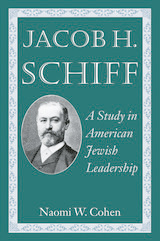
Jacob H. Schiff
A Study in American Jewish Leadership
Naomi W. Cohen
Brandeis University Press, 1999
The life of Jacob Schiff (1847 - 1920), banker, financier, and leader of the American Jewish community from 1880 to 1920, is in many ways the quintessential story of an immigrant's success in America. Born in Frankfurt in 1847, Schiff worked in several financial firms in Germany and the US before accepting a position at the New York banking firm of Kuhn, Loeb & Company in 1875 and settling for good in America. Part of a wealthy and powerful German Jewish circle that included the Warburgs and Rothschilds, Schiff played a central role in shaping American and European Jewish history. From his base on Wall Street, he was the foremost Jewish leader in what became known as the "Schiff era," grappling with all major issues and problems of the day, including the plight of Russian Jews under the czar, American and international anti-Semitism, care of needy Jewish immigrants, and the rise of Zionism. Based on a broad range of primary sources, Naomi W. Cohen's study emphasizes the role Schiff played as the preeminent leader of American Jewry at the turn of the century.
[more]

The Japanese Iris
Currier McEwen
Brandeis University Press, 1990
An international authority on irises offers the first definitive book in English on the history and cultivation of the Japanese iris.
[more]
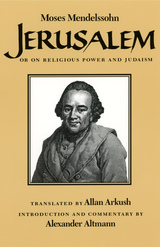
Jerusalem
Or on Religious Power and Judaism
Moses Mendelssohn
Brandeis University Press, 1983
A classic text of enduring significance, Moses Mendelssohn’s Jerusalem (1783) stands as a powerful plea for the separation of church and state and also as the first attempt to present Judaism as a religion eminently compatible with the ideas of the Enlightenment. Allan Arkush’s new translation, drawing upon the great strides made by Mendelssohn research in recent decades, does full justice to contemporary insights into the subject while authentically reflecting a distinguished eighteenth-century text. Alexander Altmann’s learned introduction opens up the complex structure and background of Mendelssohn’s ideas. His detailed commentary, keyed to the text, provides references to literary sources and interpretations of the philosopher’s intent.
[more]
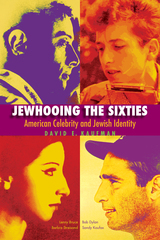
Jewhooing the Sixties
American Celebrity and Jewish Identity—Sandy Koufax, Lenny Bruce, Bob Dylan, and Barbra Streisand
David E. Kaufman
Brandeis University Press, 2012
Sandy Koufax, Lenny Bruce, Bob Dylan, and Barbra Streisand first came to public attention in the early 1960s, a period Kaufman identifies as historically ripe for American Jews to reexamine their (Jewish) identities. All four achieved extraordinary success in their respective fields and became celebrities within an American context, while at the same time they were clearly identifiable as Jews—although they were perceived to be Jewish in very different ways. Kaufman investigates these celebrities’ rise to fame, the specific brand of Jewishness each one represented, and how their fans and the public at large perceived their ethnic identity as Jews. Situating Koufax, Bruce, Dylan, and Streisand within the larger history of American Jewish celebrity, Kaufman argues that the four early 1960s figures represent a turning point between celebrity Jews of the past—such as Hank Greenberg, Groucho Marx, Irving Berlin, and Fanny Brice—and those of the present, such as Jon Stewart, Matisyahu, and Natalie Portman. Providing an entry into Jewish celebrity studies, this lively narrative explores the intersection between popular celebrity and Jewish identity and thereby examines the cultural construction of Jewishness in the latter half of the twentieth century.
[more]
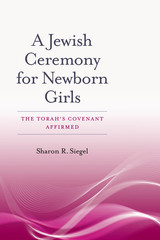
A Jewish Ceremony for Newborn Girls
The Torah’s Covenant Affirmed
Sharon R. Siegel
Brandeis University Press, 2014
This engaging book offers the first in-depth analysis of the history, philosophy, and social trends that underpin modern welcoming ceremonies for newborn girls in the Jewish community. Sharon R. Siegel traces the arc of these ceremonies from their emergence in the 1970s until today. She also delves into the history of how Jewish girls have been named over the centuries and explores how this history can shape contemporary welcoming practices. Siegel builds on the notion that modern ceremonies should focus on a newborn girl’s entry into the covenant between God and Israel and examines classic Jewish texts that speak to the critical question of women’s inclusion in the covenant. A bold new perspective on the relation between the covenant and male circumcision reveals why the covenantal status of Jewish women stands independent of this male rite. Siegel formulates a vision for the next phase in the development of Jewish rituals for newborn girls by placing these new rituals within the context of Jewish law (halacha) and synthesizing a vast array of pertinent customs, imagery, and texts. Bridging traditional Jewish beliefs and modern feminist ideals, Siegel’s powerful insights draw on her experiences and personal feminist philosophy. A Jewish Ceremony for Newborn Girls is an erudite and thought-provoking narrative that will inspire wide-ranging discussions about how and why to commemorate the birth of Jewish girls.
[more]
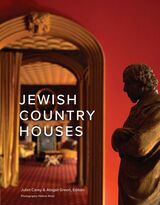
Jewish Country Houses
Edited by Juliet Carey and Abigail Green
Brandeis University Press, 2024
An exploration of the world of Jewish country houses, their architecture and collections, and the lives of the extraordinary men and women who created, transformed, and shaped them.
Country houses are powerful symbols of national identity, evoking the glamorous world of the landowning aristocracy. Jewish country houses—properties that were owned, built, or renewed by Jews—tell a more complex story of prejudice and integration, difference and connection. Many had spectacular art collections and gardens. Some were stages for lavish entertaining, while others inspired the European avant-garde. A few are now museums of international importance, many more are hidden treasures, and all were beloved homes that bear witness to the remarkable achievements of newly emancipated Jews across Europe—and to a dream of belonging that mostly came to a brutal end with the Holocaust.
Lavishly illustrated with historical images and a new body of work by the celebrated photographer Hélène Binet, this book is the first to tell the story of Jewish country houses, from the playful historicism of the National Trust’s Waddesdon Manor in Buckinghamshire to the modernist masterpiece that is the Villa Tugendhat in the Czech city of Brno—and across the pond to the United States, where American Jews infused the European country house tradition with their own distinctive concerns and experiences. This book emerges from a four-year research project funded by the UK Arts and Humanities Research Council that aims to establish Jewish country houses as a focus for research, a site of European memory, and a significant aspect of European Jewish heritage and material culture.
Country houses are powerful symbols of national identity, evoking the glamorous world of the landowning aristocracy. Jewish country houses—properties that were owned, built, or renewed by Jews—tell a more complex story of prejudice and integration, difference and connection. Many had spectacular art collections and gardens. Some were stages for lavish entertaining, while others inspired the European avant-garde. A few are now museums of international importance, many more are hidden treasures, and all were beloved homes that bear witness to the remarkable achievements of newly emancipated Jews across Europe—and to a dream of belonging that mostly came to a brutal end with the Holocaust.
Lavishly illustrated with historical images and a new body of work by the celebrated photographer Hélène Binet, this book is the first to tell the story of Jewish country houses, from the playful historicism of the National Trust’s Waddesdon Manor in Buckinghamshire to the modernist masterpiece that is the Villa Tugendhat in the Czech city of Brno—and across the pond to the United States, where American Jews infused the European country house tradition with their own distinctive concerns and experiences. This book emerges from a four-year research project funded by the UK Arts and Humanities Research Council that aims to establish Jewish country houses as a focus for research, a site of European memory, and a significant aspect of European Jewish heritage and material culture.
[more]
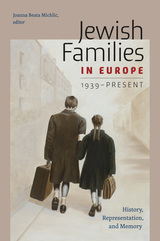
Jewish Families in Europe, 1939-Present
History, Representation, and Memory
Edited by Joanna Beata Michlic
Brandeis University Press, 2017
This book offers an extensive introduction and 13 diverse essays on how World War II, the Holocaust, and their aftermath affected Jewish families and Jewish communities, with an especially close look at the roles played by women, youth, and children. Focusing on Eastern and Central Europe, themes explored include: how Jewish parents handled the Nazi threat; rescue and resistance within the Jewish family unit; the transformation of gender roles under duress; youth’s wartime and early postwar experiences; postwar reconstruction of the Jewish family; rehabilitation of Jewish children and youth; and the role of Zionism in shaping the present and future of young survivors. Relying on newly available archival material and novel research in the areas of families, youth, rescue, resistance, gender, and memory, this volume will be an indispensable guide to current work on the familial and social history of the Holocaust.
[more]
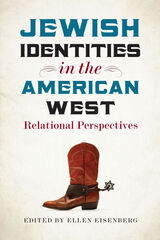
Jewish Identities in the American West
Relational Perspectives
Edited by Ellen Eisenberg
Brandeis University Press, 2022
Jewish Identities in the American West fills a significant gap in racial identity scholarship.
Since the onset of New Western History in the 1980s, the complexity of race and ethnicity as it developed in the American West has increasingly been recognized by scholars and the wider public alike. Ethnic studies scholars have developed new perspectives on racial formation in the West that complicate older notions that often relied on binary descriptions, such as Black/white racialization. In the past few decades, these studies have relied on relational approaches that focus on how race is constructed, by both examining interactions with the white dominant group, and by exploring the multiple connections with other racial/ethnic groups in society. Historians are discovering new stories of racial construction, and revising older accounts, to integrate these new perspectives into the formation of racial and ethnic identities. This collection of essays on Jews in the American West advances this field in multiple ways. With essays that cover the period from the mid-nineteenth century to the present, these authors present a collective portrait of change over time that allows us to view the shifting nature of Jewish identity in the West, as well as the evolving frameworks for racial construction. Thorough and thought-provoking, Jewish Identities in the American West takes readers on a journey of racial and ethnic identity in the American West.
Since the onset of New Western History in the 1980s, the complexity of race and ethnicity as it developed in the American West has increasingly been recognized by scholars and the wider public alike. Ethnic studies scholars have developed new perspectives on racial formation in the West that complicate older notions that often relied on binary descriptions, such as Black/white racialization. In the past few decades, these studies have relied on relational approaches that focus on how race is constructed, by both examining interactions with the white dominant group, and by exploring the multiple connections with other racial/ethnic groups in society. Historians are discovering new stories of racial construction, and revising older accounts, to integrate these new perspectives into the formation of racial and ethnic identities. This collection of essays on Jews in the American West advances this field in multiple ways. With essays that cover the period from the mid-nineteenth century to the present, these authors present a collective portrait of change over time that allows us to view the shifting nature of Jewish identity in the West, as well as the evolving frameworks for racial construction. Thorough and thought-provoking, Jewish Identities in the American West takes readers on a journey of racial and ethnic identity in the American West.
[more]
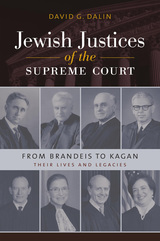
Jewish Justices of the Supreme Court
From Brandeis to Kagan
David G. Dalin
Brandeis University Press, 2017
Jewish Justices of the Supreme Court examines the lives, legal careers, and legacies of the eight Jews who have served or who currently serve as justices of the U.S. Supreme Court: Louis D. Brandeis, Benjamin Cardozo, Felix Frankfurter, Arthur Goldberg, Abe Fortas, Ruth Bader Ginsburg, Stephen G. Breyer, and Elena Kagan. David Dalin discusses the relationship that these Jewish justices have had with the presidents who appointed them, and given the judges’ Jewish background, investigates the antisemitism some of the justices encountered in their ascent within the legal profession before their appointment, as well as the role that antisemitism played in the attendant political debates and Senate confirmation battles. Other topics and themes include the changing role of Jews within the American legal profession and the views and judicial opinions of each of the justices on freedom of speech, freedom of religion, the death penalty, the right to privacy, gender equality, and the rights of criminal defendants, among other issues.
[more]
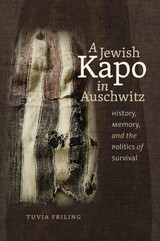
A Jewish Kapo in Auschwitz
History, Memory, and the Politics of Survival
Tuvia Friling
Brandeis University Press, 2014
Eliezer Gruenbaum (1908–1948) was a Polish Jew denounced for serving as a Kapo while interned at Auschwitz. He was the communist son of Itzhak Gruenbaum, the most prominent secular leader of interwar Polish Jewry who later became the chairman of the Jewish Agency’s Rescue Committee during the Holocaust and Israel’s first minister of the interior. In light of the father’s high placement in both Polish and Israeli politics, the denunciation of the younger Gruenbaum and his suspicious death during the 1948 Arab-Israeli war add intrigue to a controversy that really centers on the question of what constitutes—and how do we evaluate—moral behavior in Auschwitz. Gruenbaum—a Jewish Kapo, a communist, an anti-Zionist, a secularist, and the son of a polarizing Zionist leader—became a symbol exploited by opponents of the movements to which he was linked. Sorting through this Rashomon-like story within the cultural and political contexts in which Gruenbaum operated, Friling illuminates key debates that rent the Jewish community in Europe and Israel from the 1930s to the 1960s.
[more]
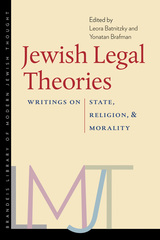
Jewish Legal Theories
Writings on State, Religion, and Morality
Edited by Leora Batnitzky and Yonatan Brafman
Brandeis University Press, 2018
Contemporary arguments about Jewish law uniquely reflect both the story of Jewish modernity and a crucial premise of modern conceptions of law generally: the claim of autonomy for the intellectual subject and practical sphere of the law. Jewish Legal Theories collects representative modern Jewish writings on law and provides short commentaries and annotations on these writings that situate them within Jewish thought and history, as well as within modern legal theory. The topics addressed by these documents include Jewish legal theory from the modern nation-state to its adumbration in the forms of Orthodox, Conservative, and Reform Judaism in the German-Jewish context; the development of Jewish legal philosophy in Eastern Europe beginning in the eighteenth century; Ultra-Orthodox views of Jewish law premised on the rejection of the modern nation-state; the role of Jewish law in Israel; and contemporary feminist legal theory.
[more]
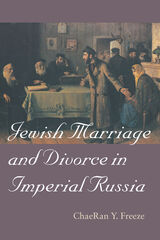
Jewish Marriage and Divorce in Imperial Russia
ChaeRan Y. Freeze
Brandeis University Press, 2001
ChaeRan Freeze explores the impact of various forces on marriage and divorce among Jews in 19th-century Russia. Challenging romantic views of the Jewish family in the shtetl, she shows that divorce rates among Russian Jews in the first half of the century were astronomical compared to the non-Jewish population. Even more surprising is her conclusion that these divorce rates tended to drop later in the century, in contrast to the rising pattern among populations undergoing modernization. Freeze also studies the growing involvement of the Tsarist state. This occurred partly at the behest of Jewish women contesting patriarchy and parental power and partly because the government felt that Jewish families were in complete anarchy and in need of order and regulation. Extensive research in newly-declassified collections from twelve archives in Russia, Ukraine, and Lithuania enables Freeze to reconstruct Jewish patterns of marriage and divorce and to analyze the often conflicting interests of Jewish husbands and wives, rabbinic authorities, and the Russian state. Balancing archival resources with memoirs and printed sources in Hebrew, Yiddish, and Russian, she offers a tantalizing glimpse of the desires and travails of Jewish spouses, showing how individual life histories reflect the impact of modernization on Jewish matchmaking, gender relations, the "emancipation" of Jewish women, and the incursion of the Tsarist state into the lives of ordinary Jews.
[more]
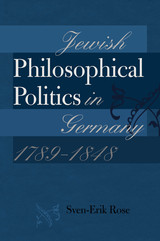
Jewish Philosophical Politics in Germany, 1789–1848
Sven-Erik Rose
Brandeis University Press, 2014
In this book Rose illuminates the extraordinary creativity of Jewish intellectuals as they reevaluated Judaism with the tools of a German philosophical tradition fast emerging as central to modern intellectual life. While previous work emphasizes the “subversive” dimensions of German-Jewish thought or the “inner antisemitism” of the German philosophical tradition, Rose shows convincingly the tremendous resources German philosophy offered contemporary Jews for thinking about the place of Jews in the wider polity. Offering a fundamental reevaluation of seminal figures and key texts, Rose emphasizes the productive encounter between Jewish intellectuals and German philosophy. He brings to light both the complexity and the ambivalence of reflecting on Jewish identity and politics from within a German tradition that invested tremendous faith in the political efficacy of philosophical thought itself.
[more]
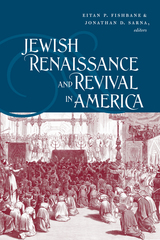
Jewish Renaissance and Revival in America
Edited by Eitan P. Fishbane and Jonathan D. Sarna
Brandeis University Press, 2011
In the late 1870s, shaken by rapid socioeconomic change, internal crises, and the rise of antisemitism, young Jews assumed leadership, created dozens of organizations, and inspired masses of followers. These organizations helped define the nineteenth-century Jewish awakening: cultural and religious renewal, and the promotion of Jewish education. Expanding upon the unfinished work of Leah Levitz Fishbane, this volume seeks to broaden our understanding of this period, which paved the way for new developments in American Jewish communal, cultural, and religious life.
[more]
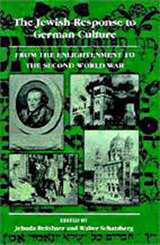
The Jewish Response to German Culture
From the Enlightenment to the Second World War
Jehuda Reinharz
Brandeis University Press, 1991
Seventeen scholars explore the interaction between a Jewish culture with its ancient heritage and an expansive German culture in the process of modernization.
[more]
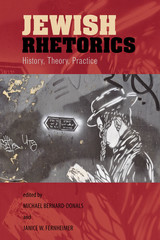
Jewish Rhetorics
History, Theory, Practice
Edited by Michael Bernard-Donals and Janice W. Fernheimer
Brandeis University Press, 2014
This volume, the first of its kind, establishes and clarifies the significance of Jewish rhetorics as its own field and as a field within rhetoric studies. Diverse essays illuminate and complicate the editors’ definition of a Jewish rhetorical stance as allowing speakers to maintain a “resolute sense of engagement” with their fellows and their community, while also remaining aware of the dislocation from the members of those communities. Topics include the historical and theoretical foundations of Jewish rhetorics; cultural variants and modes of cultural expression; and intersections with Greco-Roman, Christian, Islamic, and contemporary rhetorical theory and practice. In addition, the contributors examine gender and Yiddish, and evaluate the actual and potential effect of Jewish rhetorics on contemporary scholarship and on the ways we understand and teach language and writing. The contributors include some of the world’s leading scholars of rhetoric, writing, and Jewish studies.
[more]
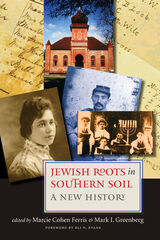
Jewish Roots in Southern Soil
A New History
Edited by Marcie Ferris and Mark I. Greenberg
Brandeis University Press, 2006
Jews have long been a presence in the American South, first arriving in the late seventeenth century as part of exploratory voyages from Europe to the New World. Two of the nation’s earliest Jewish communities were founded in Savannah in 1733 and Charleston in 1749. By 1800, more Jews lived in Charleston than in New York City. Today, Jews comprise less than one half of one percent of the southern population but provide critical sustenance and support for their communities. Nonetheless, southern Jews have perplexed scholars. For more than a century, historians have wrestled with various questions. Why study southern Jewish history? What is the southern Jewish experience? Is southern Jewish culture distinctive from that of other regions of the country, and if so, why? Jewish Roots in Southern Soil: A New History addresses these questions through the voices of a new generation of scholars of the Jewish South. Each of this book’s thirteen chapters reflects a response with particular attention paid to new studies on women and gender; black/Jewish relations and the role of race, politics, and economic life; popular and material culture; and the changes wrought by industrialization and urbanization in the twentieth century. Essays address historical issues from the colonial era to the present and in every region of the South. Topics include assimilation and American Jewish identity, southern Jewish women writers, the Jewish Confederacy, Jewish peddlers, southern Jewish racial identity, black/Jewish relations, demographic change, the rise of American Reform Judaism, and Jews in southern literature.
[more]
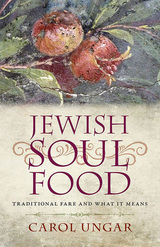
Jewish Soul Food
Traditional Fare and What It Means
Carol Ungar
Brandeis University Press, 2015
Jewish traditional foods often have symbolic meanings. A Passover matzo is a taste of Egyptian slavery. The Hanukkah latke reminds us of the little jug of oil that burned, miraculously, for eight nights. Noshing hamentaschen at Purim, we remember the villain Haman, and his thwarted plan to destroy the Jews. Even more than in the synagogue, Jewish life takes place around the dining table. Jewish sages compare the dining table to an altar, and that isn’t an exaggeration. Jewish meals are ceremonies and celebrations that forge a pathway between body and soul. In this unique cookbook, Carol Ungar links the cultural and religious symbolism of Jewish foods to more than one hundred recipes drawn from international Jewish cultures and traditions. She offers easy-to-follow recipes for Shabbat meals and all the Jewish holidays, from Rosh Hashana to the nine days before Tisha b’Av, along with fascinating briefs on how many Jewish foods—challah, kreplach, farfel, and more—express core Jewish beliefs. With ingredients that can be found in any supermarket, and recipes adapted for the time- and health-conscious cook, this volume is for anyone who wishes to flavor Shabbat and holiday meals with Jewish soul.
[more]
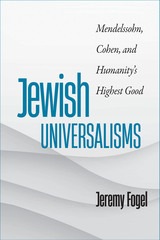
Jewish Universalisms
Mendelssohn, Cohen, and Humanity’s Highest Good
Jeremy Fogel
Brandeis University Press, 2023
An original and comprehensive comparison of the universalisms of two major modern Jewish philosophers.
Any version of universalism relevant to a more attentive, pluralistic, and postcolonial outlook would balance the urgent current need for a universalistic perspective with the desire to maintain the richness of human diversity. The modern Jewish philosophers who sought to partake in the Enlightenment’s universalistic vision while maintaining their distinct identities as members of a religious minority within Europe offer insightful answers.
Jewish Universalisms analyzes how two major figures, Moses Mendelssohn and Hermann Cohen, dealt with the perceived tension between the universal values characteristic of the Enlightenment and aspects of Judaism often depicted as particularistic and parochial. Jeremy Fogel joins this lively debate in modern Jewish philosophy, offering a comparative examination of these thinkers and analyzing their worldviews from an innovative axiological perspective. Fogel writes that to gain a precise understanding of how Mendelssohn and Cohen argued for the concordance of Judaism and universalism, one must first seek out what they delineated as ultimately valuable. Then one can work out how that highest good, and the method of valuation it sustains, are universal.
Any version of universalism relevant to a more attentive, pluralistic, and postcolonial outlook would balance the urgent current need for a universalistic perspective with the desire to maintain the richness of human diversity. The modern Jewish philosophers who sought to partake in the Enlightenment’s universalistic vision while maintaining their distinct identities as members of a religious minority within Europe offer insightful answers.
Jewish Universalisms analyzes how two major figures, Moses Mendelssohn and Hermann Cohen, dealt with the perceived tension between the universal values characteristic of the Enlightenment and aspects of Judaism often depicted as particularistic and parochial. Jeremy Fogel joins this lively debate in modern Jewish philosophy, offering a comparative examination of these thinkers and analyzing their worldviews from an innovative axiological perspective. Fogel writes that to gain a precise understanding of how Mendelssohn and Cohen argued for the concordance of Judaism and universalism, one must first seek out what they delineated as ultimately valuable. Then one can work out how that highest good, and the method of valuation it sustains, are universal.
[more]
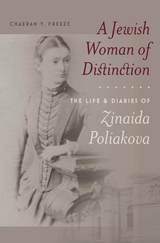
A Jewish Woman of Distinction
The Life and Diaries of Zinaida Poliakova
ChaeRan Y. Freeze
Brandeis University Press, 2019
Zinaida Poliakova (1863–1953) was the eldest daughter of Lazar Solomonovich Poliakov, one of the three brothers known as the Russian Rothschilds. They were moguls who dominated Russian finance and business and built almost a quarter of the railroad lines in Imperial Russia.
For more than seventy-five years, Poliakova kept detailed diaries of her world, giving us a rare look into the exclusive world of Jewish elites in Moscow and St. Petersburg. These rare documents reveal how Jews successfully integrated into Russian aristocratic society through their intimate friendships and patronage of the arts and philanthropy. And they did it all without converting—in fact, while staunchly demonstrating their Jewishness.
Poliakova’s life was marked by her dual identity as a Russian and a Jew. She cultivated aristocratic sensibilities and lived an extraordinarily lifestyle, and yet she was limited by the confessional laws of the empire and religious laws that governed her household. She brought her Russian tastes, habits, and sociability to France following her marriage to Reuben Gubbay (the grandson of Sir Albert Abdullah Sassoon). And she had to face the loss of almost all her family members and friends during the Holocaust.
Women’s voices are often lost in the sweep of history, and so A Jewish Women of Distinction is an exceptional, much-needed collection. These newly discovered primary sources will change the way we understand the full breadth of the Russian Jewish experience.
For more than seventy-five years, Poliakova kept detailed diaries of her world, giving us a rare look into the exclusive world of Jewish elites in Moscow and St. Petersburg. These rare documents reveal how Jews successfully integrated into Russian aristocratic society through their intimate friendships and patronage of the arts and philanthropy. And they did it all without converting—in fact, while staunchly demonstrating their Jewishness.
Poliakova’s life was marked by her dual identity as a Russian and a Jew. She cultivated aristocratic sensibilities and lived an extraordinarily lifestyle, and yet she was limited by the confessional laws of the empire and religious laws that governed her household. She brought her Russian tastes, habits, and sociability to France following her marriage to Reuben Gubbay (the grandson of Sir Albert Abdullah Sassoon). And she had to face the loss of almost all her family members and friends during the Holocaust.
Women’s voices are often lost in the sweep of history, and so A Jewish Women of Distinction is an exceptional, much-needed collection. These newly discovered primary sources will change the way we understand the full breadth of the Russian Jewish experience.
[more]
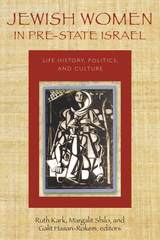
Jewish Women in Pre-State Israel
Life History, Politics, and Culture
Edited by Ruth Kark, Margalit Shilo, and Galit Hasan-Rokem
Brandeis University Press, 2008
This fascinating interdisciplinary collection of essays brings gender issues to the foreground in order to redress a profound imbalance in the historiography of the Yishuv, the Jewish community in Palestine, and in the early years of the State of Israel. Although male discourse still dominates this field, some initial studies have begun to create an authentic and multifaceted Hebrew-Israeli voice by examining the activities and contributions of women. This research has led to a number of basic questions: What was the reality of life for women in Jewish society in Ottoman and Mandatory Palestine (Eretz Israel), and in the early years of the State? What was the contribution of women to the renewal of Israeli society and culture? What is the place of gender perceptions in the study of the new local identity? The original articles in this anthology forge an innovative response to one or more of these questions, and reflecting the state of research in the field.
[more]
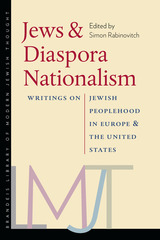
Jews and Diaspora Nationalism
Writings on Jewish Peoplehood in Europe and the United States
Edited by Simon Rabinovitch
Brandeis University Press, 2012
The question of how to preserve, construct or transform Jewish peoplehood consumed Jewish intellectuals in the late nineteenth and early twentieth centuries. Despite a rich array of writing from Jewish nationalists, liberals, and socialists about the vitality of Jewish existence in the diaspora, the key works have never been collected in a single volume, and few reliable English translations exist. This anthology brings together a variety of thinkers who offered competing visions of peoplehood within the established and developing Jewish diaspora centers of Europe and America. Writing in Russian, Yiddish, Hebrew, French, and English, these Jewish intellectuals sought to recast Jewish existence, whether within multiethnic empires, liberal democracies, or socialist forms of government, in national terms. Volume editor Simon Rabinovitch provides an introductory essay, as well as short introductions and annotations to each document that contextualize and make accessible this wealth of primary sources for scholars and students.
[more]
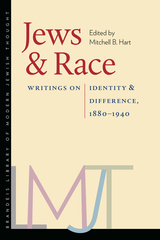
Jews and Race
Writings on Identity and Difference, 1880–1940
Edited by Mitchell B. Hart
Brandeis University Press, 2011
Many people think of Jews as victims of a particular sort of racism, not as active participants in the development of racial thinking in the nineteenth and twentieth centuries. Yet many Jews did take up racial discourse and used it to analyze Judaism, Jewish history, and the contemporary condition of world Jewry. Race discourse generated by Jews was in part apologetic, a response to racial antisemitism; however, it also served other political and ideological needs. Focusing primarily on works written at the height of the racial hygiene and eugenics movements in Europe and North America, this diverse anthology shows how Jewish scholars and popular writers in Europe, North America, and Palestine developed racial interpretations of Judaism and Jewish history, thereby raising fascinating and thorny issues about the nature and history of racial discourse in Europe and America. Designed for class adoption, the volume contains annotations and an introduction by the editor.
[more]
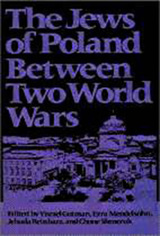
The Jews of Poland Between Two World Wars
Edited by Yisrael Gutman
Brandeis University Press, 1991
Jews have long seen the interwar years as a “golden age” for Polish Jewry and hold it in special reverence because of the community’s heroic struggle against the encroaching darkness of antisemitism. During the years 1918 to 1939, Polish Jews constituted the largest Jewish community in noncommunist Europe and were the leading cultural and political force in the Jewish Diaspora. In this volume distinguished American, West European, Israeli, and Polish scholars combine forces to explore the politics, antisemitism, economic and social life, religious patterns, and cultural creativity of a period whose relevance is heightened because of current changes under way in Eastern Europe.
[more]
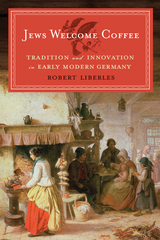
Jews Welcome Coffee
Tradition and Innovation in Early Modern Germany
Robert Liberles
Brandeis University Press, 2012
Tracing the introduction of coffee into Europe, Robert Liberles challenges long-held assumptions about early modern Jewish history and shows how the Jews harnessed an innovation that enriched their personal, religious, social, and economic lives. Focusing on Jewish society in Germany in the seventeenth and eighteenth centuries, and using coffee as a key to understanding social change, Liberles analyzes German rabbinic rulings on coffee, Jewish consumption patterns, the commercial importance of coffee for various social strata, differences based on gender, and the efforts of German authorities to restrict Jewish trade in coffee, as well as the integration of Jews into society.
[more]
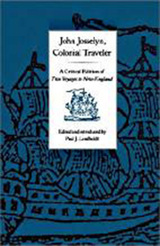
John Josselyn, Colonial Traveler
A Critical Edition of Two Voyages to New-England.
John. Josselyn and Paul J. Lindholdt
Brandeis University Press, 1988
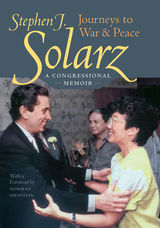
Journeys to War and Peace
A Congressional Memoir
Stephen J. Solarz
Brandeis University Press, 2011
In this remarkable book, recounting his long, influential career as a congressman from New York, Stephen Solarz gives an insider’s view of the life of a hard-working legislator in the forefront of democracy movements and human rights during a tumultuous time in our nation’s history. A member of the class of 1974, the so-called “Watergate” class, when 75 freshman Democrats were elected to the Congress, Solarz was part of the group that brought about a power shift in the House from an inner circle of senior committee chairs to a much larger group of subcommittee leaders. Early on he sought and won a seat on the House Foreign Affairs Committee, where he earned a reputation as an expert in international relations, traveling to more than 100 countries and meeting the likes of Anwar Sadat, Menachem Begin, Nelson Mandela, Indira Gandhi, Saddam Hussein, Kim Il Sung, and Robert Mugabe. Solarz gives fascinating, detailed descriptions of his role in bringing democracy to South Korea and Taiwan, the triumph of people power in the Philippines, the peace agreement in Cambodia, the abolition of apartheid in South Africa, and the adoption of the resolution authorizing the use of force in the first Gulf War. Written in an engaging style, Journeys to War and Peace will appeal to all who value the struggle for human rights and seek a better understanding between differing cultures and peoples.
[more]
READERS
Browse our collection.
PUBLISHERS
See BiblioVault's publisher services.
STUDENT SERVICES
Files for college accessibility offices.
UChicago Accessibility Resources
home | accessibility | search | about | contact us
BiblioVault ® 2001 - 2024
The University of Chicago Press









